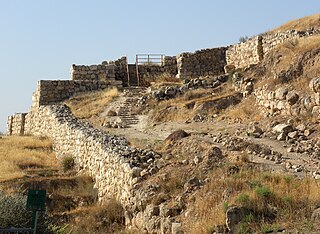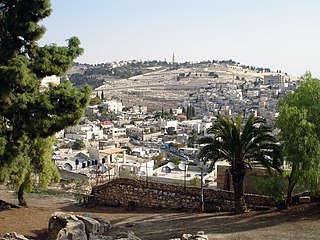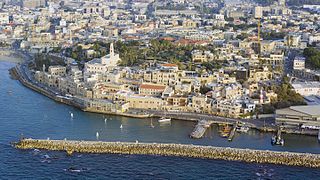
Lachish was an ancient Canaanite and Israelite city in the Shephelah region of Israel, on the south bank of the Lakhish River, mentioned several times in the Hebrew Bible. The current tell (ruin) by that name, known as Tel Lachish or Tell ed-Duweir, has been identified with the biblical Lachish. Today, it is an Israeli national park operated and maintained by the Israel Nature and Parks Authority. It lies near the present-day Moshav of Lakhish.

Ramla or Ramle is a city in the Central District of Israel. Ramle is one of Israel's mixed cities, with significant numbers of both Jews and Arabs.

Ness Ziona is a city in Central District, Israel. In 2022 it had a population of 50,341, and its jurisdiction was 15,579 dunams (15.579 km2 [6.015 sq mi]).

Ono was a biblical town of Benjamin in the "plain of Ono". The modern Kiryat Ono is not to be confused with the biblical Ono.

Israel Finkelstein is an Israeli archaeologist, professor emeritus at Tel Aviv University and the head of the School of Archaeology and Maritime Cultures at the University of Haifa. Finkelstein is active in the archaeology of the Levant and is an applicant of archaeological data in reconstructing biblical history. Finkelstein is the current excavator of Megiddo, a key site for the study of the Bronze and Iron Ages in the Levant.

Gezer, or Tel Gezer, in Arabic: تل الجزر – Tell Jezar or Tell el-Jezari is an archaeological site in the foothills of the Judaean Mountains at the border of the Shfela region roughly midway between Jerusalem and Tel Aviv. It is now an Israeli national park. In the Hebrew Bible, Gezer is associated with Joshua and Solomon.

Jonathan Apphus was one of the sons of Mattathias and the leader of the Hasmonean dynasty of Judea from 161 to 143 BCE.

Kedesh was an ancient Canaanite and later Israelite settlement in Upper Galilee, mentioned few times in the Hebrew Bible. Its remains are located in Tel Kedesh, 3 km northeast of the modern Kibbutz Malkiya in Israel on the Israeli-Lebanese border.

Ophel is the biblical term given to a certain part of a settlement or city that is elevated from its surroundings, and probably means fortified hill or risen area. In the Hebrew Bible, the term is used about two cities: Jerusalem, as in 2 Chronicles 27:3 and 33:14 and Nehemiah 3:26 and 11:21, and Samaria, mentioned in 2 Kings 5:24. The Mesha Stele, written in Moabite, a Canaanite language closely related to Biblical Hebrew, is the only extra-biblical source using the word, also in connection to a fortified place.

Hadid is a moshav in central Israel. Located near Modi'in, it falls under the jurisdiction of Hevel Modi'in Regional Council. In 2022 it had a population of 931.

Al-Haditha was a Palestinian village in the Ramle Subdistrict. It was located 8 km northeast of Ramla, on the bank of Wadi al-Natuf. The site, now known as Tel Hadid, has yielded significant archaeological remains from many periods. Al-Haditha was depopulated during the 1948 Arab-Israeli War on July 12, 1948, under the first stage of Operation Dani.

Yavne-Yam or Minet Rubin is an archaeological site located on Israel's Southern Coastal Plain, about 15 km south of Tel Aviv. Built on eolianite hills next to a small promontory forming the sole anchorage able to provide shelter to seagoing vessels between Jaffa and the Sinai, Yavne-Yam is notable for its role as the port of ancient Yavne. Excavations carried out by Tel Aviv University since 1992 have revealed continuous habitation from the second millennium BCE up to the Middle Ages; the famous Yavne-Yam ostracon is named after the site.

Tel Shimron is an archaeological site and nature reserve in the Jezreel Valley.

Jaffa, also called Japho or Joppa in English, is an ancient Levantine port city now part of Tel Aviv-Yafo, Israel, located in its southern part. The city sits atop a naturally elevated outcrop on the Mediterranean coastline.

Rosh HaAyin South railway station is a railway station near Rosh HaAyin, Israel. Despite the name, it is located north-west of the city, near the historic site of Antipatris.

Tel Zeton (Hebrew: תל זיתון, also known as Tell Abu Zeitun, is an archaeological site in the Pardes Katz neighborhood of Bnei Brak, Israel. It lies 800 m south of the Yarkon River. The mound rises to a height of 9 m above its surroundings and spans an area of 2–3 dunams. The site was inhabited in the Middle Bronze Age and later in the Iron and Persian periods. Jacob Kaplan identified the fortified settlement from the Persian period as a Jewish settlement from the time of the Return to Zion in the 5th century BCE, thanks to an ostracon bearing a Hebrew name which appears in the Hebrew Bible from the time of Nehemiah, a Jewish governor appointed by the Achaemenid Empire to govern the autonomous Jewish province. The site was inhabited as late as the 10th century CE, during the Roman, Byzantine, Early Arab, and Mamluk periods.

Nadav Na'aman is an Israeli archaeologist and historian. He specializes in the study of Near East in the second and first millenniums BC. His research combines the history of the Ancient Near East, archaeology, Assyrology, and the study of the Bible. He possesses broad knowledge in all these four branches of research.

Modi’in, also Modi’im, and later, Moditha, was an ancient Jewish city located in Judea, near the modern city of Modi'in, Israel. First mentioned in the Books of Maccabees, it was the hometown of the priestly Hasmonean family, who assumed leadership over Judea following the victorious Maccabean uprising.

Khirbet el-ʻAqd or Horvat ʻEqed is an archaeological site in the Latrun salient of the West Bank, approximately 22 km northwest of Jerusalem. The site, situated on a hill, contains the ruins of an ancient fortified town dating from the Hellenistic period through the Bar Kokhba revolt, after which the site was ultimately abandoned.




















